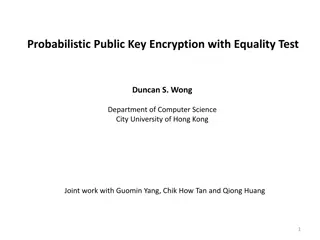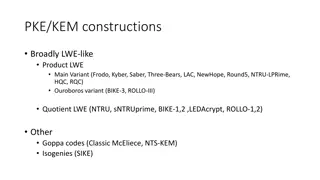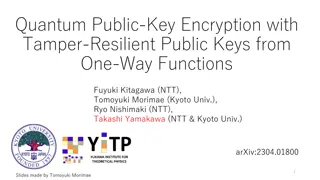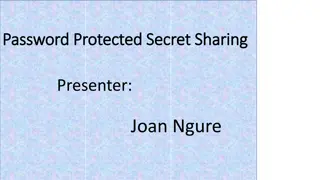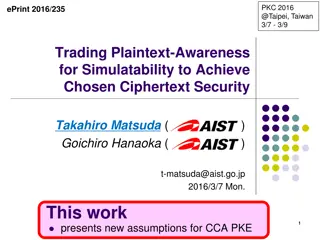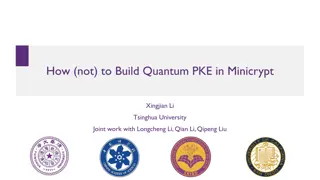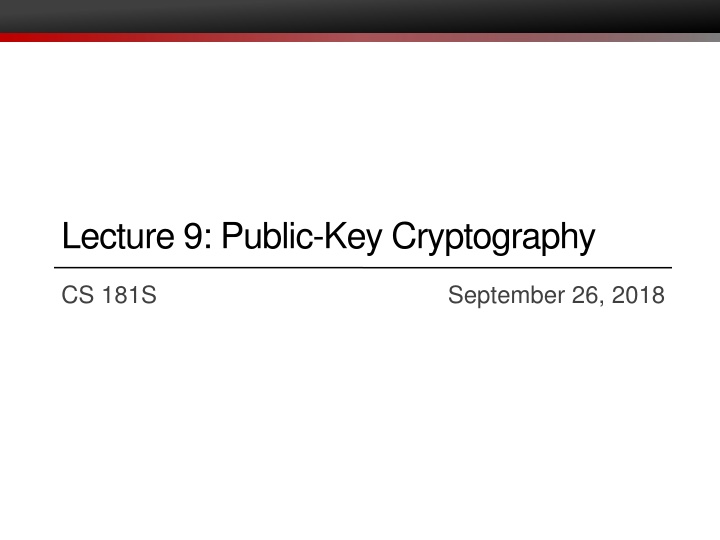
Public-Key Cryptography and RSA Algorithm
Explore the fundamentals of public-key cryptography, RSA algorithm, key pairs, padding techniques, side channels, and hybrid encryption. Learn how RSA encryption works, the importance of key pairs, and the security measures against attacks in this comprehensive guide.
Download Presentation

Please find below an Image/Link to download the presentation.
The content on the website is provided AS IS for your information and personal use only. It may not be sold, licensed, or shared on other websites without obtaining consent from the author. If you encounter any issues during the download, it is possible that the publisher has removed the file from their server.
You are allowed to download the files provided on this website for personal or commercial use, subject to the condition that they are used lawfully. All files are the property of their respective owners.
The content on the website is provided AS IS for your information and personal use only. It may not be sold, licensed, or shared on other websites without obtaining consent from the author.
E N D
Presentation Transcript
Lecture 9: Public-Key Cryptography CS 181S September 26, 2018
Key pairs Instead of sharing a key between pairs of principals... ...every principal has a pair of keys public key: published for the world to see private key: kept secret and never shared
RSA [Rivest, Shamir, Adleman 1977] Shared Turing Award in 2002: ingenious contribution to making public-key crypto Gen(len): Pick primes ?,? Choose ?,? such that ?? = 1 mod lcm(? 1,? 1) ?? = ?,? , ?? = (?,?,?) Enc(m, pk) ? = ?? mod ? Dec(c, sk): ? = ?? mod ?
Solution 1: Padding PKCS#1 v1.5: 0x00 0x02 [non-zero bytes] 0x00 [message] Vulnerable to a padding oracle attack! OAEP (Optimal Asymmetric Encryption Padding) Security proof (with assumptions)
Square-and-Multiply res = 1; while (exp > 0) { if (exp % 2 == 1){ res = res * base % p; } base = base^2 % p; exp >> 1; } return res;
Side Channels Power Timing EM Radiation Acoustics
Blinded RSA [Rivest, Shamir, Adleman 1977] Shared Turing Award in 2002: ingenious contribution to making public-key crypto Gen(len): Pick primes ?,? Choose ?,? such that ?? = 1 mod lcm(? 1,? 1) ?? = ?,? , ?? = (?,?,?) Enc(m, pk) ? = (??)? ? ? mod ? Dec(c, sk): ? = ?? mod ?
Solution 2: Hybrid encryption Assume: Symmetric encryption scheme (Gen_SE, Enc_SE, Dec_SE) Public-key encryption scheme (Gen_PKE, Enc_PKE, Dec_PKE) Use public-key encryption to establish a shared session key Avoids quadratic problem, assuming existence of phonebook Avoids problem of key distribution Use symmetric encryption to exchange long plaintext encrypted under session key Gain efficiency of block cipher and mode
Protocol to exchange encrypted message m 0. B: (pk_B, sk_B) = Gen_PKE(len_PKE) publish (B, pk_B) 1. A: k_s = Gen_SE(len_SE) c1 = Enc_PKE(k_s; pk_B) c2 = Enc_SE(m; k_s) 2. A -> B: c1, c2 3. B: k_s = Dec_PKE(c1; sk_B) m = Dec_SE(c2; k_s)
Session keys If key compromised, only those messages encrypted under it are disclosed Used for a brief period then discarded cryptoperiod: length of time for which key is valid in this case, for a single (long) message not intended for reuse in future messages only intended for unidirectional usage: A->B, not B->A
Recall: Key pairs Instead of sharing a key between pairs of principals... ...every principal has a pair of keys public key: published for the world to see private key: kept secret and never shared
Key pair terminology Encryption Digital Signatures Public key Encryption key Verification key Private key Decryption key Signing key
Digital signature scheme A digital signature scheme is a triple (Gen, Sign, Ver): Gen(len): generate a key pair (pk,sk) of length len Sign(m; sk): sign message m with key sk, producing signature s as output Ver(m, s; sk): verify signature s on message m with key pk Sign
DSA DSA: Digital Signature Algorithm [Kravitz 1991] Standardized by NIST and made available royalty-free in 1991/1993 Used for decades without any serious attacks Closely related to Elgamal encryption
RSA Core ideas are the same as RSA encryption Common mistake: RSA sign = encrypt with private key Truth (in real world, outside of textbooks): there's a core RSA function R that works with either pk or sk RSA encrypt = do some prep work on m then call R with pk RSA sign = do different prep work on m then call R with sk Prep work: recall textbook RSA is insecure (For encryption: OAEP) For signatures: PSS (probabilistic signature scheme) Also need to handle long messages
Signatures with hashing 1. A: s = Sign(H(m); k_A) 2. A -> B: m, s 3. B: accept if Ver(H(m); s; K_A)
Blind signatures [Chaum 1983] Purpose: signer doesn t know what they are signing Two additional algorithms: Blind and Unblind Unblind(Sign(Blind(m); k)) = Sign(m; k) Uses: e-cash, e-voting
Group signatures [Chaum and van Heyst 1991] Purpose: one member of group signs anonymously on behalf of group Introduces a group manager who controls membership Two new protocols: Join and Revoke, to manage membership One new algorithm: Open, which manager can run to reveal who signed a message

